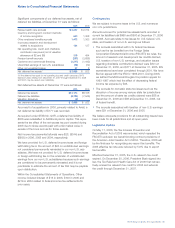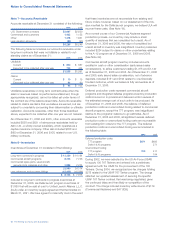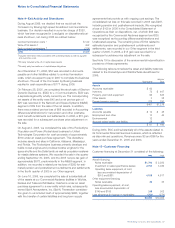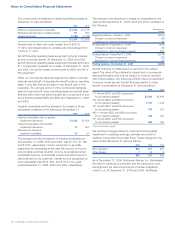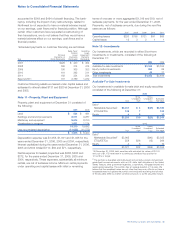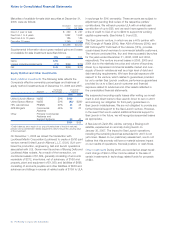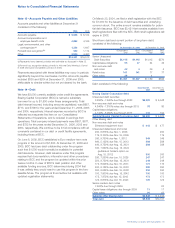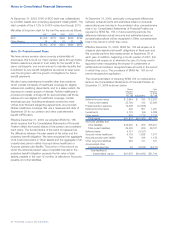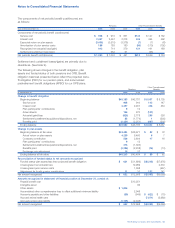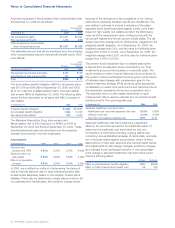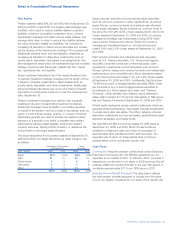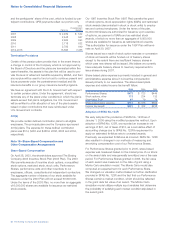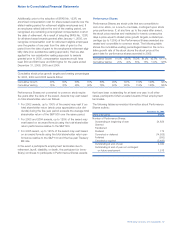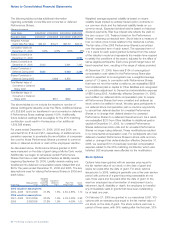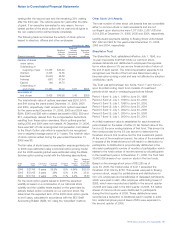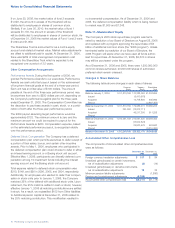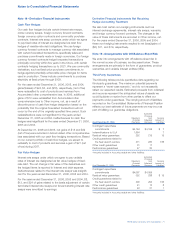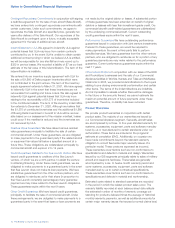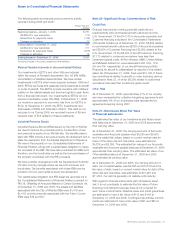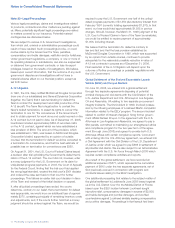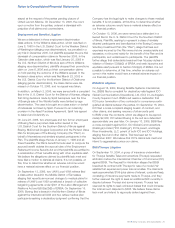Boeing 2006 Annual Report Download - page 67
Download and view the complete annual report
Please find page 67 of the 2006 Boeing annual report below. You can navigate through the pages in the report by either clicking on the pages listed below, or by using the keyword search tool below to find specific information within the annual report.
The Boeing Company and Subsidiaries 65
Notes to Consolidated Financial Statements
Plan Assets
Pension assets totaled $46,203 and $43,484 at September 30,
2006 and 2005. In late 2006, the pension asset strategy was
modified, with a goal to reduce volatility relative to pension
liabilities, achieve a competitive investment return, achieve
diversification between and within various asset classes, and
manage other risks. In order to reduce the volatility between
the value of pension assets and liabilities, the company is
increasing its allocation to fixed income securities and increas-
ing the duration of its fixed income holdings. The company will
additionally address return and diversification objectives by
increasing its allocation to alternative investments, such as
private equity, real estate, real assets, and hedge funds. Key
risk management areas which we address through this modified
strategy include funded status risk, interest rate risk, market
risk, operational risk, and liquidity.
Actual investment allocations vary from target allocations due
to periodic investment strategy changes and the length of time
it takes to complete investments in asset classes such as
private equity, real estate, and other investments. Additionally,
actual and target allocations vary due to the timing of benefit
payments or contributions made on or near the measurement
date, September 30.
Pension investment managers are retained with a specific
investment role and corresponding investment guidelines.
Investment managers have the ability to purchase securities
on behalf of the pension fund and invest in derivatives, such as
equity or bond futures, swaps, options, or currency forwards.
Derivatives generally are used to achieve the desired market
exposure of a security or an index, to transfer value-added
performance between asset classes, achieve the desired
currency exposure, adjust portfolio duration, or rebalance the
total portfolio to the target asset allocation.
The actual allocations for the pension assets at September 30,
2006 and 2005, and target allocations by asset category, are
as follows:
Percentage of Plan Assets Target
at September 30, Allocations
Asset Category 2006 2005 2006 2005
Equity 55%61%28%50%
Debt 37 31 45 31
Private equity 3366
Real estate 3376
Other 2214 7
100%100%100%100%
Equity includes domestic and international equity securities,
such as common, preferred or other capital stock, as well as
equity futures, currency forwards and residual cash allocated
to the equity managers. Equity includes our common stock in
the amounts of $1,260 (2.8% of plan assets) and $1,494 (3.4%
of plan assets) at September 30, 2006 and 2005. A currency
management strategy was implemented during 2006 which
uses currency forwards and options. Equity and currency
management derivatives based on net notional amounts
totaled 6.6% and 2.3% of plan assets at September 30, 2006
and 2005.
Debt includes domestic and international debt securities,
such as U.S. Treasury securities, U.S. Government agency
securities, corporate bonds and commercial paper; cash
equivalents; investments in bond derivatives such as bond
futures, options, swaps and currency forwards; and redeemable
preferred stock and convertible debt. Bond derivatives based
on net notional amounts totaled 7.0% and 3.9% of plan assets
at September 30, 2006 and 2005. Additionally, Debt includes
“To-Be-Announced” mortgage-backed securities (TBA), which
are contracts to buy or sell mortgage-backed securities to
be delivered at a future agreed upon date, and “Treasury
Forwards”, which similarly have delayed, future settlement
dates. Debt included $1,770 and $1,549 related to TBA securi-
ties and Treasury Forwards at September 30, 2006 and 2005.
Private equity represents private market investments which are
generally limited partnerships. Real estate includes investments
in private and public real estate. The Other category includes
alternative investments such as real assets, global tactical asset
allocation strategies, and hedge funds.
We held $89 and $82 in trust fund assets for OPB plans at
September 30, 2006 and 2005. Most of these funds are
invested in a balanced index fund which is comprised of
approximately 60% equities and 40% debt securities. The
expected rate of return on these assets does not have a
material effect on the net periodic benefit cost.
Cash Flows
Contributions Required pension contributions under Employee
Retirement Income Security Act (ERISA) regulations are not
expected to be material in 2007. In February 2007, we made a
discretionary contribution to our plans of $509 (pre-tax). We will
evaluate additional contributions later in the year. We expect to
contribute approximately $17 to our OPB plans in 2007.
Estimated Future Benefit Payments The table below reflects
the total pension benefits expected to be paid from the plans
or from our assets, including both our share of the benefit cost


